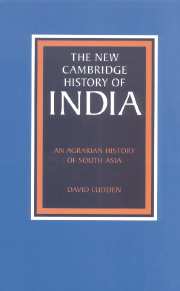1 - Agriculture
Published online by Cambridge University Press: 28 March 2008
Summary
Most of human history in South Asia is a feature of life on the land, but most documents that we use to write agrarian history concern the state. Kautilya’s Arthasastra set the tone by putting farming and herding under the heading of state revenue. Hundreds of thousands of stone and copper inscriptions appear in the first millennium of the Common Era (ce). Scattered across the land from Nepal to Sri Lanka, they documented agrarian conditions, but their purpose was rather to constitute medieval dynasties. After 1300, official documents narrate more and more powerful states. In the sixteenth century, Mughal sultans built South Asia’s first empire of agrarian taxation, and their revenue assessments, collections, and entitlements produced more data on agrarian conditions than any previous regime. In 1595, Abu-l Fazl’s Ai’n-i Akbari depicted agriculture in accounts of imperial finance. After 1760, English officials did the same. After 1870, nationalists rendered the country as part of the nation, and since 1947 agriculture has been a measure of national development. For two millennia, elites have recorded agrarian facts to bolster regimes and to mobilise the opposition, so we inherit a huge archive documenting agrarian aspects of historical states.
Over the centuries, however, agrarian history has also moved along in farming environments, outside the institutional structure of states, almost always connected in one way or another to state authority, but embedded basically in the everyday life of agricultural communities. Dynasties expand into agrarian space. Empires incorporate farm and forest, using various degrees and types of power, gaining here, losing there, adapting to local circumstances and modifying state institutions to embrace new regions of cultivation.
- Type
- Chapter
- Information
- An Agrarian History of South Asia , pp. 6 - 59Publisher: Cambridge University PressPrint publication year: 1999



